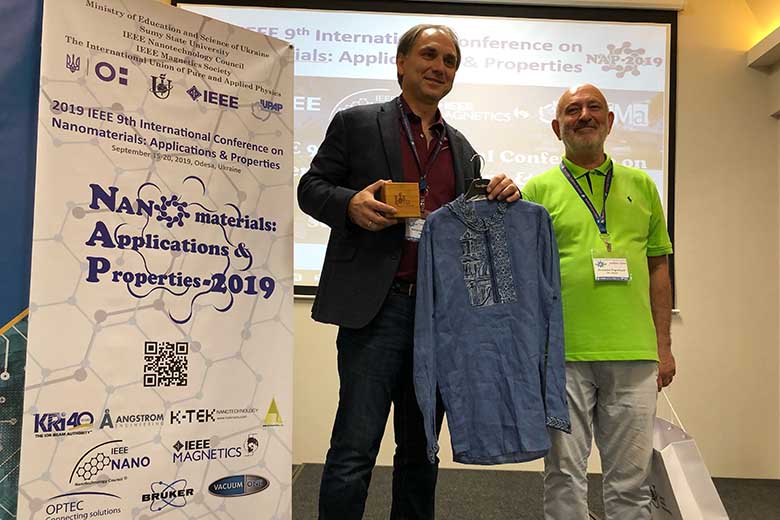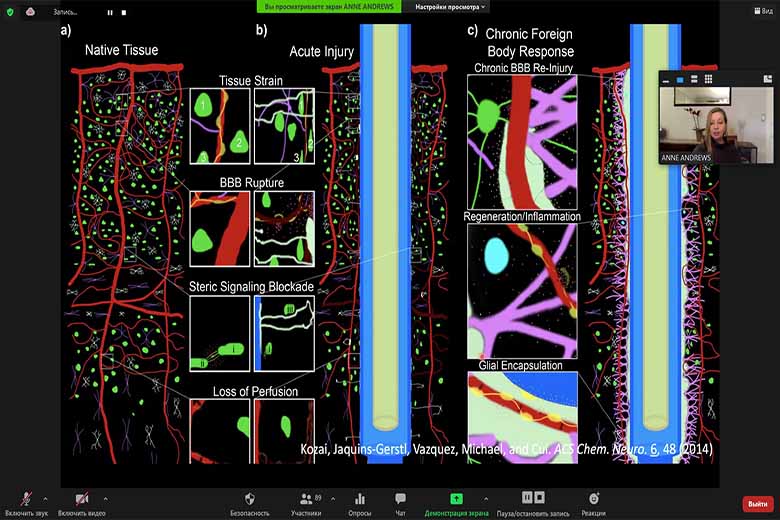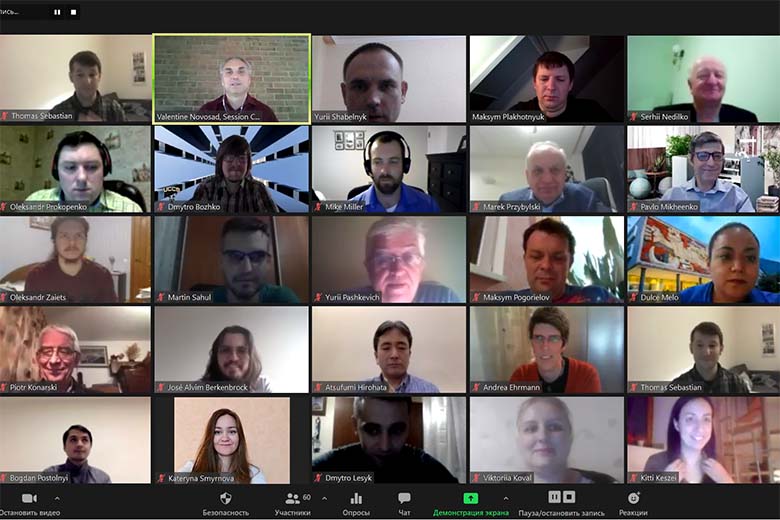International Conference "Nanomaterials: Applications & Properties" (NAP)

Submission of materials for the International Conference "Nanomaterials: Applications & Properties" (NAP) held by Sumy State University (SumDU) in conjunction with the IEEE Nanotechnology Council continues from January 15 to May 17, 2021. More than 200 participants from about 30 countries worldwide take part in the Conference annually.
Yuriy Shabelnyk, Secretary of the Conference, Deputy Dean for Research at the Faculty of Electronics and Information Technologies (ElIT), SumDU, Candidate of Physical and Mathematical Sciences, talks about the details of organization and grants for participants.
The focus of the Conference is new fundamental and applied results concerning the use and properties of different groups of nanomaterials and coatings. Nanomaterials include any objects or substances whose structural elements are nanoscale (1 to 100 nm). This determines their unique physical properties which significantly differ from the properties of bulk materials. The Conference is multidisciplinary and consists of 12 thematic areas – from synthesis methods of nanomaterials and transport properties of nanoscale systems to biomedicine and application of nanomaterials in green energy. Noteworthy is the area concerning physics of magnetic phenomena and materials and their application in various industries. The official language of the Conference is English.

Who is the organizer of the Conference?
For the first time, the Conference was initiated by Professor Serhiy Protsenko, the first Dean of the ElIT Faculty (SumDU), and Professor Alexander Pogrebnjak. The idea was supported and developed by Professor Pawel Zukowski, Lublin University of Technology (Poland), and Associate Professor Taras Lyutyy (SumDU). In recent years, the Conference "Nanomaterials: Applications & Properties" (NAP) has been organized by Sumy State University and the Ministry of Education and Science of Ukraine in cooperation with international scientific communities, such as the IEEE Nanotechnology Council, the International Union of Pure and Applied Physics (IUPAP), and the IEEE Magnetics Society. Such cooperation significantly expanded the geography of participants and raised the level of the Conference. For more than ten years in a row, the Organizing Committee of the Conference has been headed by Doctor of Physical and Mathematical Sciences, Head of the Department of Nanoelectronics and Surface Modification of SumDU, Professor Alexander Pogrebnjak.

Where is the Conference held?
Over the decade, the Conference has changed four locations. For the first time in 2011 and the following years, it was held in Alushta. The Conference participants willingly went to the resort town on the Black Sea coast. In addition to a rich scientific program, the Conference also offered interesting cultural excursions for the participants. In 2014, the Conference moved to Lviv, in 2017-2019 – to the Odessa region. Initially, it was held in an urban village Zatoka, and then in the city Odessa. In 2020, due to quarantine restrictions, the Conference was held online, and we hope that this year we will be able to return to Odessa again.
Tell us about the program and participants of the Conference?
The Conference brings together about 200 participants annually, including international experts, renowned scientists, as well as young scientists, graduate students and undergraduates. Most foreign participants come from Western Europe, the United States and Asia. The Conference program usually includes up to 150 posters and 100 oral presentations.
On the first day of the Conference, a large plenary session is held, during which world-renowned scientists in the field of nanomaterials and/or condensed matter physics give a speech. In 2018, the Conference was attended by Professor Yuri Gogotsi – Ukrainian and American scientist in the fields of Material Chemistry, Materials Science and Engineering and Nanotechnology, Professor at Drexel University, Philadelphia (USA), Trustee Chair Professor of Materials Science at Drexel University since 2000, Founder and Director of the Drexel Nanotechnology Institute (since 2014 – Drexel Nanomaterials Institute) since 2003. In 2019, the Conference was attended by Professor James Morris from the University of Portland (USA), President of the IEEE Nanotechnology Council, and Professor Paul S. Weiss, UC Presidential Chair, Distinguished Professor of Chemistry and Biochemistry, Bioengineering, and of Materials Science and Engineering, the University of California, Los Angeles (USA), Founder and Editor-in-Chief of the scientific journal ACS Nano of the American Chemical Society. In 2020, Professor Gleb Yushin, co-Founder of Sila Nanotechnologies, Inc., a company that develops and implements nanomaterials for energy storage, and co-Editor-in-Chief of Materials Today, gave a plenary presentation on the novel nanomaterials that can significantly improve the energy efficiency of modern high-capacity electric batteries. Professor Anne Andrews (University of California, Los Angeles, USA), who received an Eli Lilly Outstanding Young Analytical Chemist Award in 2021 from the International Union of Pure and Applied Chemistry (IUPAC), agreed to speak at the plenary session in 2021.
In the following days, breakout sessions on specific topics are held. The Symposium on Additive Technologies and Their Applications was organized for the first time as a side event in 2020. The Symposium participants spoke about advanced methods of 3D production of different types of materials, in particular, ceramics, polymers and metals, their modeling and design, including machine-learning methods, application of additive technologies in various fields of human activity, and the fight against the COVID-19 coronavirus pandemic among others.
We actively promote science among young people, so both experienced well-known scientists and graduate students can be the speakers at such meetings.

This is a great opportunity for young scientists not only to get acquainted with leading research in the field of nanomaterials, but also to present their own work, get competent feedback, make useful acquaintances for future joint projects. As an example, we can mention the case when in 2018, after speaking at the Conference, Margarita Lisovenko, a graduate student of the Department of Nanoelectronics and Surface Modification of SumDU, was invited for short-term training and later received a position in the High Energy Physics division of the Argonne National Laboratory (USA), where she is developing superconducting detectors for cosmic microwave background.
During the last few years, participants have the opportunity to attend the Conference with the support of travel grants. Please, tell us what do these grants provide and who can apply for them?
Since 2017, the Conference has been sponsored by international organizations and recognized global companies working in the field of nanotechnology. Due to the support of sponsors, the Conference participants are awarded travel grants covering the registration fee, accommodation, expenses for social activities provided by the Conference, and in some cases travel costs as well. There are four categories of participants who can apply for a grant. The first is full-time students and postgraduate students who present their research in the field of biomedicine and are citizens of Ukraine. Grants for the second category – Ukrainian and foreign postgraduate students and students – are provided by the IEEE Magnetics Society. Members of the international organization IEEE Magnetics Society are eligible to compete for these grants. There are also grants for young researchers regardless of the scientific field they are engaged in.
Grants for women in science are provided separately. It so happened that most of the speakers and participants of the Conference are men, so this category of grants contributes to the popularization of science among women.

In 2020, the Conference took place online. What has changed in its format?
The experience of 2020 became new for us, because the Conference was held online for the first time. On the one hand, this made it possible to attract more participants and expand the geography – this year the Conference was attended by representatives of 31 countries; on the other hand, we had to completely reorganize the event. A special feature was the morning and evening online sessions, as the participants and speakers represented countries from different continents. The morning sessions began at 10 a.m. by Kyiv time and were aimed at participants from Ukraine, Asia, Europe and Africa. And, for example, speakers from California or Georgia (USA) attended the Conference in the evening, these sessions began at 5:30 p.m.

Moreover, it was necessary to unite the speakers and participants in thematic areas, therefore, several online sessions were held in parallel. It was the first time we faced such a situation, thus we had to adjust and major efforts on reorganization were made. But it was a new and valuable experience.
And finally, why exactly would you recommend attending the Conference "Nanomaterials: Applications & Properties" (NAP) and how to apply for it?
The Conference brings together a large number of internationally recognized scientists, thus promoting informal exchange of ideas and allowing to find like-minded people and contacts for further scientific cooperation. In addition, the conference proceedings are published in the IEEE Xplore Digital Library and are indexed by many scientometric databases, in particular, Scopus.
Therefore, we invite everyone to participate in the 11th annual International Conference "2021 IEEE 11th International Conference on Nanomaterials: Applications & Properties", which will be held from 5 to 11 September 2021 at the hotel "Gagarinn", Odesa, Ukraine. More detailed information about the Conference, requirements for materials and opportunities for travel grants can be found on the Conference website.